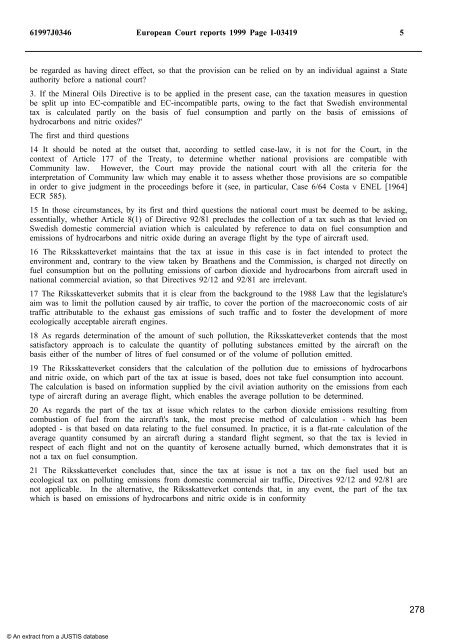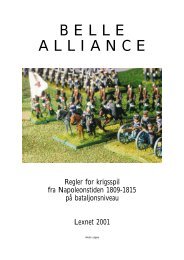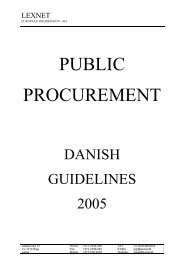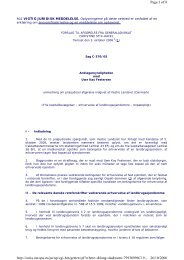Master's Program 2004/2005 Technical and Fiscal Barriers ... - Lexnet
Master's Program 2004/2005 Technical and Fiscal Barriers ... - Lexnet
Master's Program 2004/2005 Technical and Fiscal Barriers ... - Lexnet
Create successful ePaper yourself
Turn your PDF publications into a flip-book with our unique Google optimized e-Paper software.
61997J0346 European Court reports 1999 Page I-03419 5<br />
be regarded as having direct effect, so that the provision can be relied on by an individual against a State<br />
authority before a national court?<br />
3. If the Mineral Oils Directive is to be applied in the present case, can the taxation measures in question<br />
be split up into EC-compatible <strong>and</strong> EC-incompatible parts, owing to the fact that Swedish environmental<br />
tax is calculated partly on the basis of fuel consumption <strong>and</strong> partly on the basis of emissions of<br />
hydrocarbons <strong>and</strong> nitric oxides?'<br />
The first <strong>and</strong> third questions<br />
14 It should be noted at the outset that, according to settled case-law, it is not for the Court, in the<br />
context of Article 177 of the Treaty, to determine whether national provisions are compatible with<br />
Community law. However, the Court may provide the national court with all the criteria for the<br />
interpretation of Community law which may enable it to assess whether those provisions are so compatible<br />
in order to give judgment in the proceedings before it (see, in particular, Case 6/64 Costa v ENEL [1964]<br />
ECR 585).<br />
15 In those circumstances, by its first <strong>and</strong> third questions the national court must be deemed to be asking,<br />
essentially, whether Article 8(1) of Directive 92/81 precludes the collection of a tax such as that levied on<br />
Swedish domestic commercial aviation which is calculated by reference to data on fuel consumption <strong>and</strong><br />
emissions of hydrocarbons <strong>and</strong> nitric oxide during an average flight by the type of aircraft used.<br />
16 The Riksskatteverket maintains that the tax at issue in this case is in fact intended to protect the<br />
environment <strong>and</strong>, contrary to the view taken by Braathens <strong>and</strong> the Commission, is charged not directly on<br />
fuel consumption but on the polluting emissions of carbon dioxide <strong>and</strong> hydrocarbons from aircraft used in<br />
national commercial aviation, so that Directives 92/12 <strong>and</strong> 92/81 are irrelevant.<br />
17 The Riksskatteverket submits that it is clear from the background to the 1988 Law that the legislature's<br />
aim was to limit the pollution caused by air traffic, to cover the portion of the macroeconomic costs of air<br />
traffic attributable to the exhaust gas emissions of such traffic <strong>and</strong> to foster the development of more<br />
ecologically acceptable aircraft engines.<br />
18 As regards determination of the amount of such pollution, the Riksskatteverket contends that the most<br />
satisfactory approach is to calculate the quantity of polluting substances emitted by the aircraft on the<br />
basis either of the number of litres of fuel consumed or of the volume of pollution emitted.<br />
19 The Riksskatteverket considers that the calculation of the pollution due to emissions of hydrocarbons<br />
<strong>and</strong> nitric oxide, on which part of the tax at issue is based, does not take fuel consumption into account.<br />
The calculation is based on information supplied by the civil aviation authority on the emissions from each<br />
type of aircraft during an average flight, which enables the average pollution to be determined.<br />
20 As regards the part of the tax at issue which relates to the carbon dioxide emissions resulting from<br />
combustion of fuel from the aircraft's tank, the most precise method of calculation - which has been<br />
adopted - is that based on data relating to the fuel consumed. In practice, it is a flat-rate calculation of the<br />
average quantity consumed by an aircraft during a st<strong>and</strong>ard flight segment, so that the tax is levied in<br />
respect of each flight <strong>and</strong> not on the quantity of kerosene actually burned, which demonstrates that it is<br />
not a tax on fuel consumption.<br />
21 The Riksskatteverket concludes that, since the tax at issue is not a tax on the fuel used but an<br />
ecological tax on polluting emissions from domestic commercial air traffic, Directives 92/12 <strong>and</strong> 92/81 are<br />
not applicable. In the alternative, the Riksskatteverket contends that, in any event, the part of the tax<br />
which is based on emissions of hydrocarbons <strong>and</strong> nitric oxide is in conformity<br />
© An extract from a JUSTIS database<br />
278







